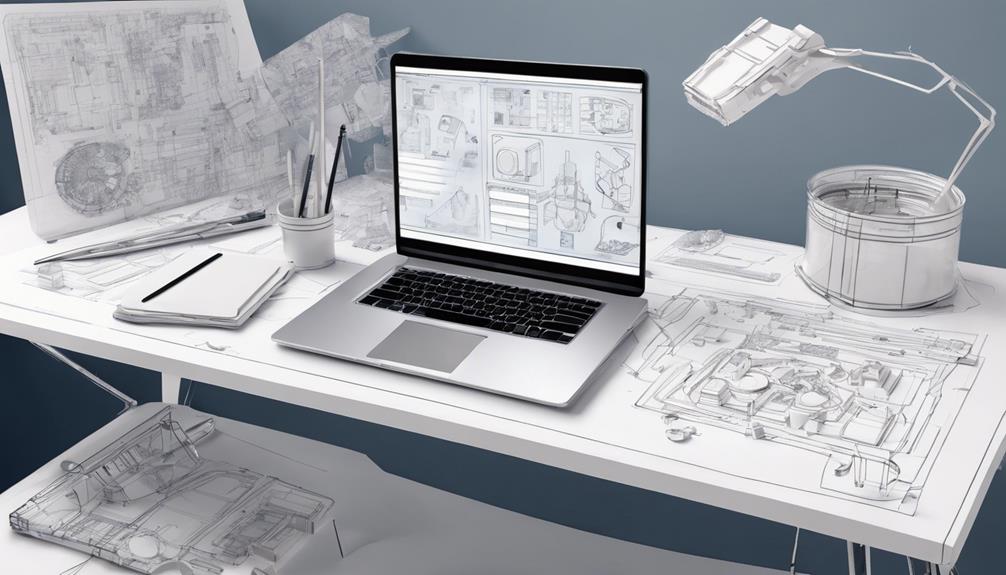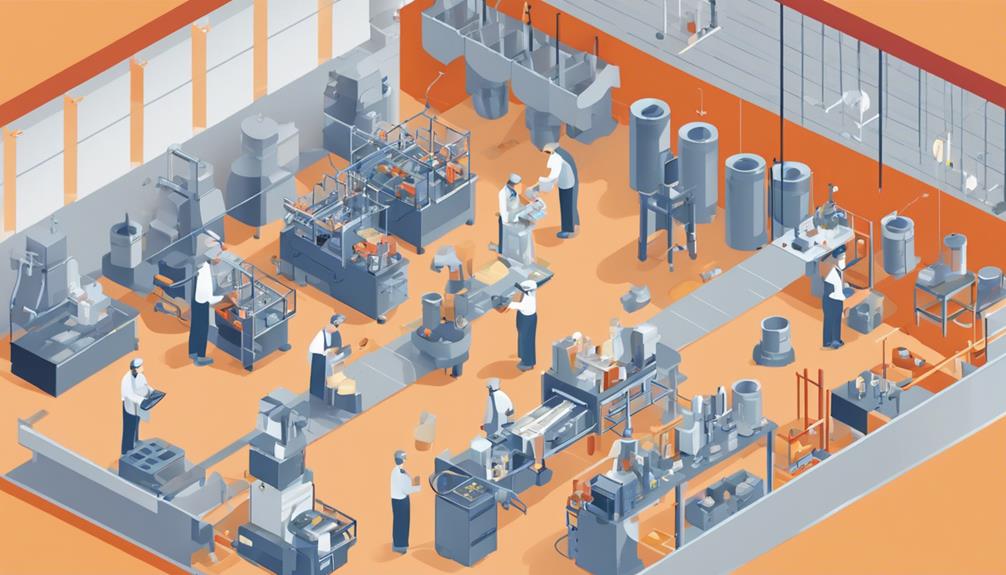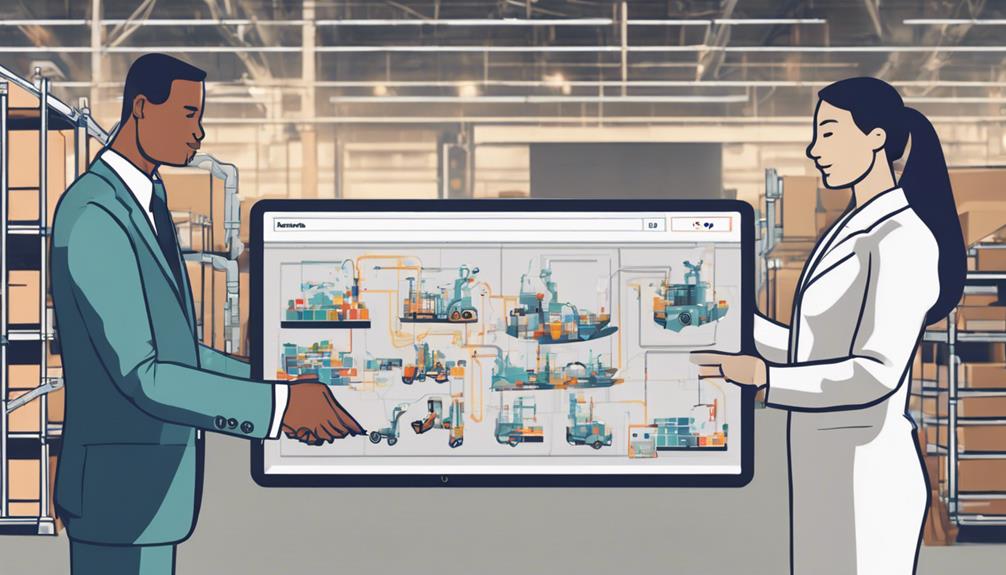To guarantee successful low-volume prototype manufacturing, it's imperative to take into account several key factors. Selecting the right PCB material is indispensable, as it impacts performance, reliability, and cost. Optimizing design for manufacturability reduces complexity and costs, while effective communication strategies foster seamless collaboration between design and manufacturing teams. Rapid prototyping techniques accelerate the design process, and minimizing production costs is crucial. Quality control measures must also be implemented, and partnering with reliable suppliers is essential. By heeding these essential tips, manufacturers can navigate the complexities of low-volume prototype production. To uncover the nuances of each, explore these critical considerations in greater detail.
Key Takeaways
- Choose the right PCB material to ensure optimal performance, reliability, and cost-effectiveness in low-volume prototype manufacturing.
- Optimize your design for manufacturability by considering production constraints, reducing complexity, and iterating on feedback.
- Establish seamless communication between design and manufacturing teams through regular updates, feedback, and digital tools.
- Leverage rapid prototyping techniques like 3D printing, CNC machining, and vacuum casting to accelerate the design process and reduce production time.
- Implement cost-effective production methods like 3D printing, CNC machining, injection molding, and sheet metal fabrication to minimize waste and reduce costs.
Selecting the Right PCB Material
When designing a low-volume prototype, the selection of the right PCB material is vital, as it greatly impacts the performance, reliability, and cost of the electronic prototype. In low-volume manufacturing, the use of high-quality PCB materials is essential to guarantee ideal product performance.
The choice of material depends on various factors, including dielectric constant, thermal conductivity, and mechanical strength. FR-4, a popular choice for PCB prototypes, offers good electrical properties at an affordable price.
However, high-frequency applications may require advanced materials like Rogers 4350B, which boasts a low loss tangent and stable dielectric constant. For high-speed and high-frequency applications, PTFE materials offer superior performance, albeit at a higher cost.
In different low-volume manufacturing scenarios, designers must consider the specific requirements of their product and select the most suitable PCB material. By doing so, they can ensure the production of high-quality parts that meet the desired specifications.
Optimizing Design for Manufacturability

Effective design for manufacturability is crucial in low-volume prototype manufacturing. It enables the creation of products that can be efficiently produced with minimal complexity and cost. This involves designing products that are easy to produce in low-volume production, taking into account factors such as material selection, part complexity, and manufacturing processes during the design phase.
By optimizing design for manufacturability, production costs and lead times can be greatly reduced in low-volume manufacturing.
To achieve this, designers should utilize design guidelines and seek manufacturability feedback from manufacturers to guarantee that the design is suitable for low-volume production. This feedback can be used to iterate on the design, improving the quality and efficiency of low-volume prototyping.
Effective Communication Strategies

In low-volume prototype manufacturing, seamless communication between design and manufacturing teams is paramount to ensuring that design intent is accurately translated into physical prototypes, thereby mitigating errors and delays. Effective communication strategies are essential to achieving this goal.
| Communication Strategy | Benefits | Tools/Methods |
|---|---|---|
| Regular Updates | Ensures alignment on project timelines and goals | Project management platforms, progress reports |
| Encouraging Feedback | Fosters collaboration and problem-solving | Open dialogue, regular meetings |
| Digital Tool Utilization | Streamlines communication and document sharing | Cloud-based project management platforms |
| Clear Design Intent | Ensures accurate translation of design intent | Design reviews, feedback loops |
| Collaboration | Minimizes errors and delays | Cross-functional teams, open communication channels |
Rapid Prototyping Techniques

By leveraging rapid prototyping techniques, design teams can accelerate the iterative design process, quickly testing and refining their concepts to achieve peak product performance.
Rapid prototyping techniques, such as 3D printing, CNC machining, and vacuum casting, enable the rapid production of prototypes, facilitating fast design iterations and modifications to test different concepts.
Additive manufacturing, employed in 3D printing, greatly reduces lead times by creating prototypes layer by layer. CNC machining, on the other hand, offers precise and high-quality prototypes by cutting materials with computer-controlled tools. Vacuum casting replicates injection-molded parts using silicone molds, making it ideal for producing small batches of prototypes.
These rapid prototyping techniques are essential for low-volume manufacturing methods, allowing designers to quickly test and refine their designs, resulting in peak product performance.
Minimizing Production Costs

While rapid prototyping techniques accelerate the design process, minimizing production costs is equally important to ensure the viability of low-volume manufacturing methods. To achieve this, it is vital to adopt cost-effective production strategies.
Additive manufacturing methods, such as 3D printing, reduce material waste and production costs, making them an ideal choice for low-volume production.
CNC machining offers precise and repeatable outputs at a lower cost, making it suitable for low-volume manufacturing.
For intricate designs, injection molding provides a cost-effective solution for quick production.
Vacuum casting is another cost-effective method for small batch production, offering a wide range of material properties.
Additionally, sheet metal fabrication is a durable and cost-effective option for complex metal parts in low-volume manufacturing.
Ensuring Quality Control Measures

When it comes to ensuring quality control measures in low-volume prototype manufacturing, it is essential to implement a rigorous material inspection process to verify the quality of incoming materials.
Additionally, effective defect detection methods are vital to identify and rectify any issues promptly, thereby preventing defective products from reaching customers.
Material Inspection Process
To safeguard the integrity of low-volume prototype manufacturing, a rigorous material inspection process is essential for verifying the quality and reliability of raw materials used in production. This process guarantees that only suitable materials are utilized, thereby maintaining the quality and performance of the final product.
Conducting thorough material testing and verification is vital to affirm the suitability and integrity of raw materials. Advanced testing equipment and techniques are utilized to assess material properties such as strength, durability, and chemical composition. Materials are inspected for any defects, inconsistencies, or impurities that could compromise the final product's quality and performance.
Establishing strict standards and protocols for material inspection maintains consistency and reliability in low-volume prototype manufacturing. By implementing a meticulous material inspection process, manufacturers can ensure that their products meet the required quality control measures, thereby enhancing their reputation and customer trust.
This process is critical to producing high-quality prototypes that meet the desired specifications and performance requirements.
Defect Detection Methods
Effective defect detection is crucial in low-volume prototype manufacturing, as it enables the identification and elimination of defects, thereby guaranteeing that only high-quality products are produced.
To achieve this, manufacturers can employ various defect detection methods. Visual inspection techniques, such as magnification and lighting, can be used to detect surface defects in prototypes.
Non-destructive testing methods, including X-ray inspection and ultrasonic testing, can identify internal defects in low-volume parts.
Dimensional inspection tools, like coordinate measuring machines (CMMs), ensure precise measurements and tolerances are met.
Additionally, automated inspection systems can be utilized for repetitive tasks to enhance efficiency and accuracy in defect detection.
Implementing statistical process control (SPC) methods can monitor and analyze manufacturing processes, ensuring consistent quality in low-volume manufacturing.
Partnering With Reliable Suppliers

When partnering with suppliers for low-volume prototype manufacturing, it is essential to establish a rigorous vetting process to guarantee the selection of reliable partners.
This involves carefully evaluating potential suppliers' quality standards, production capabilities, and material handling expertise to ensure seamless collaboration.
Supplier Vetting Process
Every successful low-volume prototype manufacturing project relies on partnering with dependable suppliers. Making a thorough supplier vetting process crucial for guaranteeing the quality and timeliness of the final product.
A detailed supplier vetting process involves several key steps to make certain that chosen suppliers meet the required standards.
- Conduct thorough background checks to verify supplier reliability and quality.
- Confirm supplier certifications, industry experience, and past track record for successful partnerships.
- Assess supplier capacity, lead times, and communication to ensure seamless collaboration.
- Request samples or prototypes to evaluate supplier capabilities and product quality firsthand.
Building Trust Quickly
By forming partnerships with reliable suppliers, manufacturers can expedite the low-volume prototype manufacturing process, ensuring timely delivery of high-quality products while minimizing the risk of production delays and associated costs.
Building trust quickly with suppliers is essential in low-volume prototype manufacturing, where time is of the essence. Trustworthy suppliers can offer cost-effective solutions and mitigate risks associated with production delays, ensuring that prototypes meet the required specifications and are delivered on time.
Establishing strong relationships with suppliers leads to smoother communication and faster turnaround times for prototypes. Additionally, reliable suppliers can provide valuable feedback and suggestions for improving the prototype design, leading to better product outcomes.
Frequently Asked Questions
What Are the Low Volume Manufacturing Techniques?
Coincidentally, the pursuit of best production methods converges with the identification of low-volume manufacturing techniques. In this domain, five prominent methods emerge: CNC machining, injection molding, 3D printing, vacuum casting, and sheet metal fabrication.
Each technique offers unique advantages, from precision and speed to cost-effectiveness and material versatility. By understanding the strengths of each method, manufacturers can strategically select the most suitable approach for their low-volume production needs.
What Are the Challenges of High Mix Low Volume Manufacturing?
In high mix low volume manufacturing, challenges abound. Managing inventory for diverse products, optimizing production setups, and allocating resources efficiently are significant hurdles. Balancing production schedules, tooling costs, and lead times is complex.
Quality control is essential to maintain consistency across product lines and guarantee customer satisfaction. Effective resource allocation, flexible manufacturing processes, and adaptive technologies are vital to overcome these challenges and achieve operational excellence.
Which Manufacturing Type Is Used Where Product Volume Is Very Low?
For very low product volumes, rapid prototyping methods are utilized to guarantee flexibility and swift turnaround times. 3D printing is a preferred choice, as it produces complex geometries and intricate designs with minimal setup time.
Alternatively, CNC machining is used for metal parts, offering high precision and repeatability.
Urethane casting is also viable for low-volume plastic parts, bridging the gap between prototyping and mass production.
What Is Considered Low Volume Production?
Low volume production is characterized by production runs of ten to tens of thousands of parts, occupying the middle ground between prototyping and mass production. This range allows for flexible production with modifications, making it ideal for testing products, validating markets, and adapting to global supply chain challenges.
In this scope, manufacturers can efficiently produce small batches while minimizing risks associated with large-scale production.


